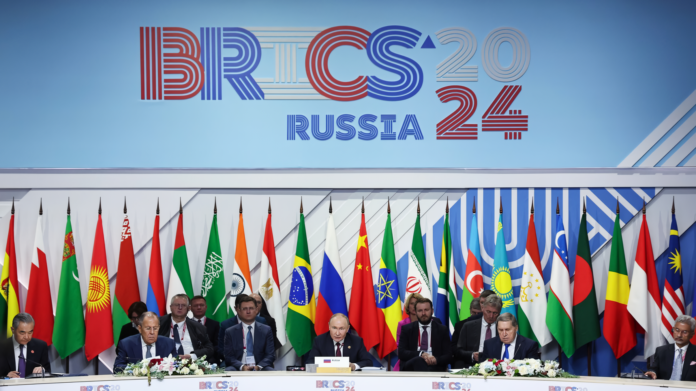
Russia and China are using all their weight in the BRICS to push their de-dollarization agenda for geopolitical and financial purposes, but at the same time, the group is facing problems that its own members are unable to deal with and where each one goes its own way and interests.
The 20.000th annual BRICS summit, which is being held in Russia for the first time in nine years, opened yesterday with a speech by Russian President Vladimir Putin, followed by a closed-door meeting. The summit, which will bring together more than 33 attendees from 20 countries, including XNUMX senior state officials, is a historic event that could mark the beginning of a new world order.
However, the de-dollarization agenda and growing tensions between the bloc's members pose significant challenges, raising questions among experts about the real impact this meeting could have.
De-dollarization: an ambitious goal
One of the first proposals of this new BRICS meeting revolves around de-dollarization, or reducing dependence on the US dollar in international trade. The idea is theoretically simple: The BRICS seek to strengthen international economic and financial cooperation, and de-dollarization is a key strategy to achieve this.
However, the implementation of this initiative faces significant obstacles, for one simple reason: Which currency will replace the dollar as the global medium of exchange?
Can BRICS boost global de-dollarization?
Faced with this question, the BRICS narrative on de-dollarization has renewed interest in the future of the US dollar as the world's reserve currency. First, because the alliance has begun testing a dollar-free payment system, which is seen as a success. But even with this progress, the reality is very clear: The dollar remains the most widely used currency in international trade.
In fact, although Russia and China already trade using the renminbi (RMB, China's currency), the reality is that these cross-border changes have very little impact at a global level, and they face a humorous situation: China and Russia carry out these exchanges in local currency (rubles and renminbi), but the operations related to these exchanges are done in dollars, euros or gold.And it's not exactly a high-value exchange either, as in 2023 alone, the exchange hit $50 billion and faces a swap line with tough restrictions.
Too much control, too little trust
Given this situation, some economists, such as Paul Krugman, winner of the Nobel Prize in Economics, indicate that this possible de-dollarization is nothing more than "much ado about nothing"Krugman argues that the dollar's dominance will remain intact and that there is no real alternative to the US currency, especially since those who push the idea of the de-dollarization, are economies with enormous capital controls and a minimal level of trust.
And this can be seen very clearly in China's financial data, where the outflow of foreign capital is growing year after year. For example, so far in 2024, China has suffered a capital outflow that has exceeded 12 billion dollars (data from the Financial Times), but in the face of this event (and in the midst of an increasingly acute financial crisis) the Chinese government only accounts for 4,8 billion dollars. It is not only financial control, but The Chinese government itself hides financial information, while tightening controls and creating bureaucracy to prevent outflows, something that leads investors to become more and more distrustful, driving up further capital outflows. The situation is not very different in Russia, where government control is much stronger.
Faced with this situation, analysts such as Mohamed El-Erian, former deputy director of the International Monetary Fund, warn that the dream of an alternative dollarization is underway and must be taken seriously. El-Erian points to a remarkable phenomenon: the price of gold has experienced a 40% increase in the last year, even though inflation has decreased. This change suggests a movement towards the search for safer assets, possibly in response to geopolitical tensions and the perception of dollar vulnerability. Basically, El-Erian says we are at a point where the dollar can easily be pushed aside, but for that to happen, a safe, reliable and easy-to-use asset must arrive on a global level.
Alternatives to the single currency
Despite aspirations for de-dollarization, the creation of a single currency for the BRICS remains in the air. Vladimir Putin has said that the idea of a single currency is not mature and that it must be done gradually and slowly. Obstacles include the economic diversity of member countries, political tensions, and the lack of integration similar to that of the European Union.
Instead, the BRICS are exploring more viable alternatives. One option is to develop integrated payment systems that allow direct transactions between each country's national currencies, increasing efficiency and resistance to international sanctions. Another possibility is to continue trading using national currencies, which would reduce dependence on the US dollar and other reserve currencies.
The latter case is more likely, but it would have no real impact on the dollar and its role as an international exchange currency, since in the end, many of these exchanges in national currencies would have their outputs from related activities using the dollar as an exchange currency.
Geopolitical tensions: the great obstacle to unity
However, de-dollarization is not the only issue on the BRICS agenda. Geopolitical tensions, especially between India and China, and new partnerships that may not be positive for the group, such as the arrival of Iran and Venezuela, are factors that complicate the unity of the bloc.
India and China: a dispute in the Himalayas
First, the geopolitical tension between India and China is a crucial factor that can change the dynamics of international trade. India, a member of the BRICS bloc, has expressed its disagreement with the de-dollarization agenda and has announced that it will continue to use the US dollar. According to Subrahmanyam Jaishankar, India's Minister of External Affairs, the country is not interested in de-dollarization and will continue to use the dollar wherever it is accepted as a form of payment.
Reasons? India sees immense danger to its economic, geopolitical and military growth in using the renminbi as a trade currency with China and Russia, two of its largest markets. And it has reason to feel endangered, because there is currently a border dispute between India and China in the Himalayan region, as well as growing distrust of China's economic and geopolitical ambitions. Despite efforts to stabilise trade relations, India prefers to keep the dollar for future transactions. This sends a clear message about its commitment to keeping the US dollar as the dominant currency.
Moreover, India sees this process of “de-dollarization” as China’s preparation to advance its military actions in the region, especially against Taiwan, something that India sees as a direct threat to its interests, since India depends entirely on Taiwan for access to chips and technology for its military and civilian technological programs.
Iran and Venezuela: dangerous relations
On the other hand, the idea of integrating Iran and Venezuela into the BRICS bloc is another factor that may complicate the group's unity. Iran, which joined the BRICS in January this year, has expressed interest in strengthening economic and political cooperation with the bloc's members. However, Iran's presence poses diplomatic challenges, especially in the context of international sanctions and tensions with the West.
And this is where Iran's secondary sanctions come into play, something that has significantly limited BRICS trade with the Persian nation. Let's remember that Iran not only has sanctions that leave it out of SWIFT, but any company that does business with Iran runs the risk of automatic sanctions. India has been especially careful and has avoided negotiation, while Russia and China negotiate for means of briefcase companies y minor banks, all in order to prevent secondary sanctions from having a negative impact on their economies.
In the case of Venezuela, history repeats itself. The South American country was among the countries that would possibly join the club at the meetings in January and October 2024, however, Brazil voted against this. The political problem, human rights and sanctions that weigh on Venezuela could seriously jeopardize Brazil's economy, and for this reason it voted against and managed to convince the rest of the countries in the bloc to abstain.
Technology and finance: the role of cryptocurrencies
On the other hand, technology and finance play a crucial role in the BRICS’ de-dollarization plans. Bitcoin mining, the development of digital payment systems, and the exploration of central bank digital currencies (CBDCs) are some of the initiatives that are pushing the bloc towards a multipolar financial system.
Bitcoin mining farms in the BRICS
In this regard, Russia, through the Russian Direct Investment Fund (RDIF) and BitRiver, the country’s largest mining company, plans to build Bitcoin mining farms in the BRICS countries. The project will not only focus on Bitcoin mining, but also on the implementation of artificial intelligence (AI) technologies. Igor Runets, CEO of BitRiver, commented that together with RDIF, they will work “on creating a mining-based infrastructure,” which involves building data centers and providing the necessary capabilities to deploy and implement AI-related projects.
Bitcoin mining in Russia has recently been legalized (after being outlawed and severely persecuted), which opens up new opportunities for the development of computing power and the implementation of advanced technologies. This project seeks not only to increase Russia's presence in Bitcoin mining, but also in the global computing power market.
BRICS Pay: a payment system without the dollar
Meanwhile, BRICS Pay, a cashless QR code payment tool, was officially launched at the BRICS Business Forum. Demo cards contained 500 rubles, which participants used to make payments at three locations of the World Trade Center in Moscow. The system is expected to go into operation by the end of this year for Russians abroad, and in 2025 for residents of Russia.
BRICS Pay will allow payments with Visa, Mastercard and WeChat Pay, and will be integrated into a series of options that will allow BRICS countries to have expanded payment options to settle goods and services. The idea is to depend less and less on the dollar, encourage financial diversification and strengthen economic autonomy among the members of the bloc.
The BRICS de-dollarization scheme includes the exploration of digital currencies and stablecoins. One of the most notable initiatives is the Common Account Unit (Unir), a gold-backed stablecoin. The new currency will be pegged to an underlying reserve basket composed of 40% gold and 60% currencies of the BRICS member countries.
Much to advance
The BRICS summit in Russia is a crucial event that could mark the beginning of a new world order. De-dollarization, financial technology, and geopolitical tensions are central issues that will define the future of the bloc. Although the BRICS have ambitious goals, the implementation of these plans faces significant challenges, especially in the context of internal tensions and new alliances.
Time will tell whether the BRICS initiatives will lead to a new financial paradigm or whether the dollar will remain the undisputed king of currencies. What is clear, however, is that the BRICS are taking concrete steps toward a multipolar financial system, and their actions will have important implications for the rest of the world.


